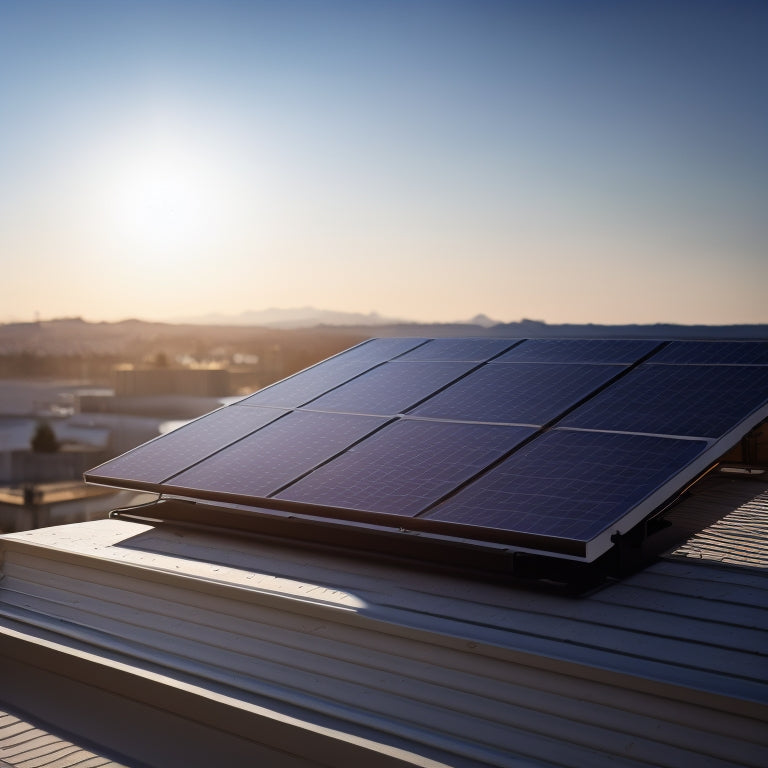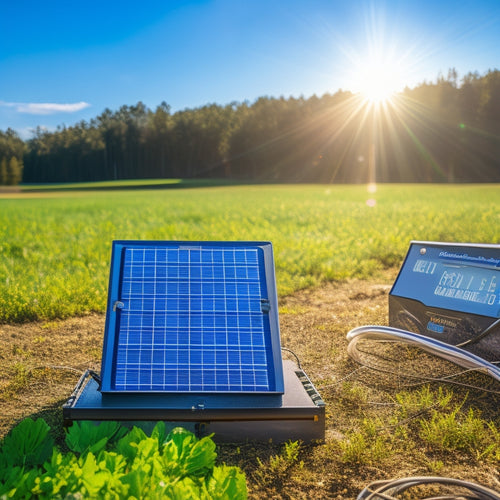
Solar Panel With Inverter and Battery
Share
You're considering a solar panel system with an inverter and battery, a setup that guarantees reliable power during grid outages, increased property value, and efficient energy management. With this system, you'll have automatic backup solutions to keep your critical home systems running, like refrigeration and lighting, during power failures. You'll also experience seamless backup power conversion, making certain your devices stay charged and communication remains uninterrupted. This setup not only provides energy independence but also enhances your property's value and appeal. As you investigate this option further, you'll uncover the complexities of MPPT, voltage regulation, and system compatibility that optimize your solar panel's performance.
The Essentials
- A solar panel system with an inverter and battery provides reliable power during grid outages, ensuring critical home systems remain functional.
- The inverter converts DC power from the solar panels to AC power for home use, while the battery stores excess energy for later use.
- Automatic backup solutions maintain uninterrupted power supply during grid failures, ensuring essential appliances continue to run smoothly.
- The inverter's Maximum Power Point Tracking (MPPT) feature optimizes energy harvesting from the solar panels, maximizing system efficiency.
- A compatible inverter and battery with matching ratings are crucial for seamless operation, optimal performance, and prolonged system lifespan.
Reliable Power During Outages
You get power when you need it with a solar panel system that includes a battery and inverter, ensuring your home or business remains operational during grid outages.
By integrating a battery storage system into your solar setup, you'll access the full potential of renewable energy and create a more sustainable, dependable, and cost-effective power solution Renewable Energy Storage.
This seamless backup solution kicks in automatically, providing a reliable source of energy when the grid fails.
With a solar panel system, you can count on having power when it matters most.
Power When You Need
A sudden power outage can disrupt daily routines and cause significant inconvenience, especially during extreme weather conditions or grid failures. You're left in the dark, wondering when the lights will come back on.
But with a solar panel system that includes an inverter and battery, you can enjoy power when you need it most. This setup allows you to utilize the sun's energy during the day and store it for later use, giving you energy independence and a sense of freedom.
By having a reliable Home Power Backup System, you can guarantee that critical home systems, such as refrigeration and lighting, continue to function smoothly, preventing food spoilage and maintaining safety.
When the grid goes down, your solar panel system kicks in, providing reliable power to your home. You can keep your lights on, your fridge running, and your communication devices charged. This means you can continue to live your life as usual, even when the rest of your neighborhood is in the dark.
Seamless Backup Solution
During grid failures or extreme weather events, a seamless backup solution is essential to maintaining uninterrupted power supply. With a solar panel system that includes an inverter and battery, you get the peace of mind that comes with reliable power during outages.
| Grid Status | Your Power Status |
|---|---|
| Grid Down | Your Power On |
| Grid Unstable | Your Power Stable |
| Grid Overloaded | Your Power Unaffected |
This setup guarantees energy independence, allowing you to live life on your own terms. You can enjoy sustainable living, free from the worries of power outages. The inverter and battery work together to provide a seamless shift from grid power to backup power, keeping your essential appliances running smoothly. With this system, you can charge your devices, keep your fridge running, and stay connected with loved ones, even when the grid is down. Experience the freedom that comes with having reliable power, whenever you need it.
Increased Property Value
You'll likely see a significant enhancement in your property's value with the installation of a solar panel system with an inverter and battery.
This upgrade can improve your property's resale value, making it more attractive to potential buyers in the future.
With top residential solar roofing solutions from companies like Tesla and Sunrun, you can increase your property's appeal and value.
Additionally, the enhanced property appeal can also increase your property's value, providing a strong selling point if you decide to put your property on the market.
Improved Resale Value
As homeowners become increasingly environmentally conscious, installing a solar panel with an inverter and battery can greatly enhance a property's resale value.
You'll benefit from increased buyer preferences, as eco-friendly features top the list of desired amenities. In fact, a study found that solar panels can increase your property's value by up to 17%. This increased value is largely due to the environmental impact of reducing your carbon footprint.
Additionally, energy independence and lower energy bills are attractive selling points for potential buyers.
Market trends show that homes with solar panels sell faster and for more money than those without. Moreover, regional incentives and financing options can offset the installation costs, making it a more accessible investment for homeowners.
With minimal maintenance requirements and rapid technological advancements, solar panels are becoming a sought-after feature in modern homes.
Enhanced Property Appeal
One of the most significant advantages of installing a solar panel with an inverter and battery is the enhanced property appeal it brings, resulting in increased property value.
You'll notice an increase in your property's curb appeal, thanks to the sleek, modern design of the solar panels. These aesthetic upgrades not only make your home stand out but also demonstrate your commitment to sustainability.
Moreover, the energy independence you gain from utilizing solar power sends a strong message to potential buyers. You're no longer reliant on the grid, and that's a freedom many people are willing to pay a premium for.
As you consider selling your property, you can confidently market it as an eco-friendly, self-sufficient home that offers a reduced carbon footprint and lower energy bills.
The enhanced property appeal of your solar-powered home is undeniable. You'll attract environmentally conscious buyers who share your values and are willing to invest in a property that reflects those values.
With a solar panel system, you're not only increasing your property value but also appealing to a growing demographic that prioritizes energy independence and sustainability.
Maximum Power Point Tracking
You'll want to optimize your solar panel's energy harvesting with Maximum Power Point Tracking (MPPT), which guarantees you're getting the most out of your system.
This is especially significant in off-grid energy solutions, where grid integration and efficient energy distribution are essential.
To achieve this, you'll need to take into account the efficiency of the MPPT algorithm, as well as the voltage regulation methods used to adapt to changing environmental conditions.
MPPT Algorithm Efficiency
Enhancing solar panel efficiency is a top priority, and that's where Maximum Power Point Tracking (MPPT) algorithms come in. You're likely aware that MPPT algorithms play a vital role in energy harvesting, as they refine the power output of your solar panel system.
But how do you measure their efficiency? To evaluate MPPT algorithm efficiency, you need to take into account factors like load profiling, system integration, and performance metrics. Real-time monitoring of your system's performance is important to identify areas for improvement.
By comparing different MPPT algorithms, you can determine which one works best for your specific setup. Temperature effects can greatly impact MPPT algorithm efficiency, so it's important to take this factor into account when selecting an algorithm.
Look for algorithms that adapt to changing temperature conditions to guarantee peak performance. When choosing an MPPT algorithm, prioritize efficiency optimization, and don't settle for anything less than the best.
With the right algorithm, you'll be able to maximize your energy harvest and enjoy the freedom that comes with renewable energy.
Voltage Regulation Methods
How do voltage regulation methods impact the efficiency of your solar panel system? Voltage stability is essential for optimal performance, and regulation techniques play a significant role in achieving it.
Maximum Power Point Tracking (MPPT) relies on adaptive control to flexibly adjust the operating voltage, guaranteeing maximum energy harvesting.
In your solar panel system, feedback loops continuously monitor voltage and current outputs, making adjustments to maintain voltage stability. Load management is imperative, as sudden changes in load can affect voltage stability.
Flexible adjustment of the inverter's output voltage guarantees that the system operates within a stable range, even under varying load conditions.
Waveform correction and frequency modulation are also fundamental in voltage regulation. These techniques enable the inverter to produce a stable, grid-compliant AC waveform, which is essential for efficient energy transfer.
Check Wattage and Voltage Ratings
You need to verify the solar panel's wattage and voltage ratings match the inverter's input limits to prevent system malfunction or damage.
The inverter's input voltage range must be compatible with the solar panel's output voltage to facilitate efficient energy conversion.
Integrating eco-friendly roof solar panels with advanced battery solutions renewable energy storage can also help generate clean energy and save on electricity bills.
It's essential to check the maximum power point tracking (MPPT) rating of the inverter to confirm it can handle the solar panel's maximum power output.
Matching Ratings Matters
Every solar panel system requires a harmonious marriage of components, where each part's ratings align to confirm seamless operation and ideal performance. You need to ascertain that the wattage and voltage ratings of your solar panels, inverter, and battery are compatible to achieve system compatibility and performance optimization.
When selecting an inverter, you should check its maximum power point tracking (MPPT) rating, which must match the solar panel's maximum power output. The inverter's input voltage range should also be compatible with the solar panel's voltage output. Failing to match these ratings can lead to reduced system performance, overheating, or even complete system failure.
Similarly, the battery's voltage and capacity ratings must align with the inverter's output and the solar panel's charging requirements. You should also consider the depth of discharge (DOD) rating of the battery, which affects its lifespan and overall system performance.
Inverter Input Limits
Within the inverter's input limits, the wattage and voltage ratings serve as vital benchmarks that dictate the compatibility of your solar panel system. These ratings determine the maximum amount of power your inverter can handle from your solar panels. Exceeding these limits can lead to system malfunction, damage, or even complete failure.
When selecting an inverter, you need to take into account the type of inverter and its input voltage range. Different inverter types, such as string inverters, microinverters, or power optimizers, have varying input voltage requirements.
For instance, string inverters typically have a narrower input voltage range compared to microinverters.
Confirm the solar panel's voltage output falls within the inverter's specified input voltage range. Check the inverter's datasheet or manufacturer's specifications to determine the maximum permitted voltage and power ratings.
Higher Surge Capacity Guaranteed
You need to verify your solar panel system can handle peak power demands without failing.
That's why you should look for a system with a higher surge capacity, which assures it can handle peak power handling.
This means the system can support sudden spikes in power consumption, such as when multiple appliances start up simultaneously.
Peak Power Handling
A significant 1.5 times surge capacity in this solar panel system guarantees that it can handle peak power demands without compromising performance or safety. You can rest confident that your system will operate at peak performance, even during periods of high energy usage. This means you'll have the freedom to power your appliances, devices, and tools without worrying about the system's ability to keep up.
The system's higher surge capacity also assures seamless system compatibility. You can connect multiple devices without fear of system overload or shutdown. Whether you're powering a small cabin, a large home, or a commercial property, this solar panel system is designed to handle the load.
In addition, the system's inverter and battery work together to provide a stable and efficient energy supply. The inverter converts the DC power from the solar panels to AC power, while the battery stores excess energy for later use.
This guarantees that you have a reliable source of power, even during periods of low sunlight or at night. With this solar panel system, you can enjoy the freedom and independence that comes with generating your own clean energy.
Frequently Asked Questions
Can I Install the System Myself or Do I Need a Professional?
You can attempt a DIY installation, but be aware of safety considerations like electrical shock and fire risks; if you're not experienced, it's recommended to hire a professional to guarantee a safe and efficient setup.
How Long Does It Take to Charge the Battery From the Grid?
As you plug into the grid, you'll be curious about the charging pace. It takes you around 2-5 hours to fully charge your battery, depending on its capacity and the charging efficiency of your system, giving you the freedom to unplug when you're ready.
Can I Use Any Type of Battery With the Inverter System?
When selecting a battery, you'll need to verify it's compatible with your inverter system, as mismatched components can compromise efficiency; look for batteries with matching voltage, capacity, and chemistry to optimize performance and assure seamless energy storage.
Will the System Work With My Existing Electrical Panel?
You'll need to assess your existing electrical panel's system compatibility before integrating the new setup; it may require panel upgrades to guarantee seamless operation, so consult an expert to determine the necessary modifications for a hassle-free changeover.
Can I Add More Batteries to the System in the Future?
You can upgrade your system's battery capacity for future expansion, allowing you to store more energy and increase your independence from the grid, as your needs evolve, you can simply add more batteries to the existing setup.
Final Thoughts
As you flip the switch, the lights stay on, a guiding light of hope in the dark, like the lighthouse directing ships through treacherous waters. Your solar panel with inverter and battery is the unsung hero, providing reliable power during outages. With it, you've increased your property value and utilized maximum power with tracking. You've checked the wattage and voltage ratings, ensuring a higher surge capacity. Now, you can weather any storm, secure in the knowledge that your power will never be just a fleeting dream.
Related Posts
-

Solar Powered Lights for Sustainable Home Decor
Solar-powered lights offer a stylish and eco-friendly way to enhance your home decor. They capture sunlight, converti...
-

Choosing the Right Solar Power Charge Controller
Choosing the right solar power charge controller is crucial for maximizing energy efficiency and extending battery li...
-

Top Solar Powered Camping Fans for Camping Enthusiasts
If you're a camping enthusiast, a solar-powered fan can be a transformative element for your outdoor experience. Thes...


